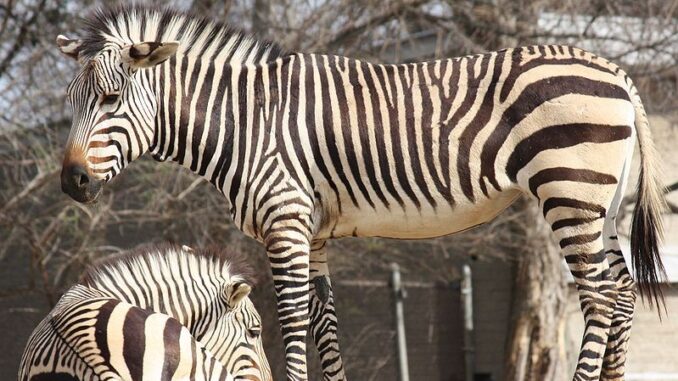
Unless you were born very, very, very recently, you probably learned in school that the purpose of stripes on a zebra are for camouflage to help the animals hide in the African brush from predators. This belief has been thought to be true for decades, if not centuries. A study published in 2019 suggests that there’s a different reason.
Multiple theories have been presented over the years to explain the reason why zebras have stripes. The crypsis hypothesis, put forth in 1896, is the one that everyone was taught and commonly believes, that the stripes help camouflage and conceal the African equine from predators.
The confusion hypothesis, first floated at least fifty years ago, predicts that the stripe pattern makes it difficult for predators to tell how many zebras are in a herd, their speed, and even their size and direction. At first, this idea seems far fetched, but similar ‘dazzle’ patterns were painted on Allied ships off and on during the First World War and at the beginning of World War Two in order to confuse submarines on the hunt. U-boat captains reported that the dazzle paint jobs were indeed effective, making it hard for subs to determine the target ship’s course, direction, and speed. The stripes did not help conceal the ship at all, however, in fact it tended to stand out more than if it had just been painted standard grey.
The aposematic hypothesis claimed the zebra’s stripes were a warning to predators. Unfortunately, there’s no evidence at all that the zebra’s primary enemy, lions, are deterred at all by the warning stripes.
The social function hypothesis promotes the idea that the stripes are useful within the zebra’s social circles, i.e., the herd. Since stripe patterns are unique to each animal, it could help zebras quickly identify each other, aid social bonding, or be used to select the most fit mate.
The thermoregulatory hypothesis postulates that black stripes are an aid to cooling, as the animals can apparently raise their black hair for cooling, while their white hair remains flat and reflects sunlight.
The fly protection hypothesis states that the stripes are there to deter biting flies, and the study mentioned above provides strong evidence for that idea. Researchers from University of California, Davis, University of Exeter (UK), and University of Bristol (UK), tested the idea by purchasing three different colors (two solids and a pattern) of horse coats which were placed on seven horse test subjects. The coats did not cover the horse’s heads. Three zebras were also included in the study as controls. The three coat colors were described as dark black, bright white, and an irregularly striped black and white zebra pattern. The equines were video recorded at a high-enough resolution to be able to count the number of flies that landed on each horse.
The team found that many flies landed on horses wearing the black coats and the white coats. However, very few flies landed on the zebras or the horses wearing the zebra pattern coat, and by a large majority most flies that attempted to land on the zebra pattern coats misjudged distance, running into the horse, but failing to land. The researchers think that the zebra pattern plays havoc with the fly’s depth perception (similar to the effect dazzle paint had on U-boat captains). By not having flies biting them, zebras avoid disease and skin irritation, not to mention painful bites. The study, published February 20, 2019, is titled “Benefits of zebra stripes: Behaviour of tabanid flies around zebras and horses“.
Question Of The Night: If costs, housing, and logistics were no obstacles, would you like keep exotic animals, such as zebras?
